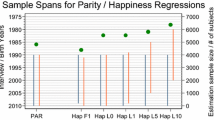Abstract
An analysis of family sex composition preferences as well as the relationship between actual family sex composition and desire for no additional children among a national sample of Filipino women is presented. An emphasis on balance or son-daughter equivalence is strongest in Metropolitan Manila. Son preference is highest in rural Mindanao and Sulu, primarily due to the concentration of Muslims in this section of the country and secondarily to its pioneer environment and the presumed utility of sons in such a milieu. The importance of eliciting sex composition preferences from both husbands and wives as well as distinguishing the “striking for a balance” from sex-linked preferences in future research is discussed.
Similar content being viewed by others
References
Alzona, Encarnacion. 1934. Social and Economic Status of the Filipino Woman from 1665to 1932. Manila: University of the Philippines Press.
Baradas, David. 1972. Conflict in the “Land of Promise.” Philippine Sociological Review 20:363–366.
Carroll, John J. 1970. The Family in a Time of Change. Pp. 10–16 in John J. Carroll et al. (eds.), Philippine Institutions. Manila: Solidaridad Publishing House.
Casino, Eric S. 1972. Integration and the Muslim Filipinos. Philippine Sociological Review 20:360–362.
Coombs, Lolagene, 1973. Comparative Fertility Analyses: A Project of the International Union for the Scientific Study of Population. Unpublished paper presented at the annual meeting of the Population Association of America, New Orleans.
Cordero, Felicidad V., and Isabel S. Panopio, 1967. General Sociology: Focus on the Philippines. Manila: College Professors Publish. ing Corporation.
Eggan, Fred. 1968. Philippine Social Structure. Pp, 1–48 in George M. Guthrie (ed.), Six Perspectives on the Philippines. Manila: Bookmark.
El-Hamamsv, Laila Shukry. 1972. Belief Systems and Family Planning in Peasant Societies. Pp. 335–337 in Harrison Brown and Edward Hutchings, Jr. (eds.), Are Our Descendants Doomed: Technological Change and Population Growth. New York: The Viking Press.
Eliot, Johan W. 1968. Urban-Rural and Berber Arab Differentials in Desired Numbers of Male Children and Related Factors in Algeria. Unpublished paper presented at the annual meeting of the Population Association of America, Boston.
Fagley, Richard. 1967. Doctrines and Attitudes of Major Religions in Regard to Fertility. Pp. 78–84 in Proceedings of the World Population Conference, 1965, Vol. II. New York: United Nations.
Freedman, Ronald. 1963. Norms for Family Size in Underdeveloped Areas. Proceedings of the Royal Society, Series B. 159:220–245.
—, and John Y. Takeshita. 1969. Family Planning in Taiwan: An Experiment in Social Change: Princeton: Princeton University Press.
GIang, Alunan C. 1972. Comment on the Baradas Paper. Philippine Sociological Review 20:371–375.
Hassan, Shafick S. 1967. Religion Versus Child Mortality as a Cause of Differential Fertility. Unpublished paper presented at the annual meeting of the Population Association of America, Cincinnati.
Hunt, Chester L. 1965. Female Occupational Roles and Urban Sex Ratios in the United States, Japan, and the Philippines. Social Forces 43:407-417.
Jocano, F. Landa. 1971. Cultural Changes in Relation to a Sustained Country-Wide Family Planning Programme. Unpublished paper presented at the Southeast Asia and Oceania Regional Conference of the International Planned Parenthood Federation, Baguio City, Philippines.
Kapadia, K. M. 1966. Marriage and Family in India (3rd ed.). Bombay: Oxford University Press.
Kirk, Dudley. 1966. Factors Affecting Moslem Natality. Pp. 561–579 in Bernard Berelson et al. (eds.), Family Planning and Population Programs. Chicago: University of Chicago Press.
Knodel, John, and Pichit Pitaktepsombati. 1973. Thailand: Fertility and Family Planning among Rural and Urban Women. Studies in Family Planning 4:229–255.
Korea, Republic of. Ministry of Health and Social Affairs. 1965. The Findings of the National Survey on Family Planning. Seoul: Planned Parenthood Federation of Korea.
Ling, T. O. 1969. Buddhist Factors in Population Growth and Control: A Survey Based on Thailand and Ceylon. Population Studies 23:53–60.
Pascual, Elvira M. 1966. Population Redistribution in the Philippines. Manila: Population Institute, University of the Philippines.
Poffenberger, Thomas. 1967. Age of Wives and Number of Living Children of a Sample of Men Who Had the Vasectomy in Meerut District, U. P. Journal of Family Welfare 13:48–51.
Prabhu, Pandarinath Hari: 1963. Hindu Social Organization: A Study in the Sociopsycho-logical and Ideological Foundations (4th ed.). Bombay: Popular Prakashan.
Prachuabmoh, Visid. 1967. Factors Affecting Desire or Lack of Desire for Additional Progeny in Rural Thailand. Pp. 364–409 in Donald Bogue (ed.), Sociological Contributions to Family Planning Research. Chicago: University of Chicago.
Prasithratsin, Suchart. 1971. Economic and Fertility Behavior of the Rural People in Thailand. Unpublished Ph.D. dissertation. Providence: Brown University.
Ramirez, Jaime B. 1971. Series on the Neglected Muslims of the South. Manila: Manila Chronicle (January).
Rizk, Hanna. 1959. Fertility Patterns in Selected Areas in Egypt. Unpublished Ph.D. dissertation. Princeton: Princeton University.
Simkins, Paul D., and Frederick L. Wernstedt. 1971. Philippine Migration: The Settlement of the Digos-Padada Valley, Davao Province. Monograph Series No. 16, Southeast Asian Studies. New Haven: Yale University.
Stewart, James C. 1972. Comment on the Baradas Paper. Philippine Sociological Review 20:367–371.
Stinner, William F., and Paul Douglas Mader. 1973a. Religion, Minority Group Status and Family Size Norms: An Assessment of Muslim-Catholic Differentials in the Southern Philippines. Unpublished paper presented at the annual meeting of the Society for the Scientific Study of Religion.
Stinner, William F., and Paul Douglas Mader. 1973b. Conflict, Acculturation and Family Size Preferences: The Case of Muslim Filipinos. Mimeo.
Wernstedt, Frederick L., and Paul D. Simkins. 1965. Migrations and the Settlement of Mindanao. Journal of Asian Studies 25:83–103.
—, and J. E. Spencer. 1967. The Philippine Island World: A Physical, Cultural, and Regional Geography. Berkeley: University of California Press.
Yaukey, David. 1961. Fertility Differences in a Modernizing Country: A Survey of Lebanese Couples. Princeton: Princeton University Press.
Author information
Authors and Affiliations
Rights and permissions
About this article
Cite this article
Stinner, W.F., Mader, P.D. Sons, Daughters or Both?: An Analysis of Family Sex Composition Preferences in the Philippines. Demography 12, 67–79 (1975). https://doi.org/10.2307/2060733
Issue Date:
DOI: https://doi.org/10.2307/2060733




